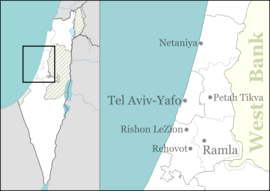Azaria
Azaria (Hebrew: עֲזַרְיָה), or Azarya is a moshav in central Israel. Located in the Shephelah around five kilometres south-east of Ramle, it falls under the jurisdiction of Gezer Regional Council. In 2019 it had a population of 1,227.[1]
Azaria עֲזַרְיָה | |
|---|---|
 Azaria  Azaria | |
| Coordinates: 31°53′20.75″N 34°54′35.27″E | |
| Country | |
| District | Central |
| Council | Gezer |
| Affiliation | Moshavim Movement |
| Founded | 30 October 1949 |
| Founded by | Jerusalemites |
| Population (2019)[1] | 1,227 |
| Website | www.azarya.org |
Etymology
Its name is symbolic, though there is a theory that it was named after Azariah of Judah. The symbolic meaning is an acronym from the Hebrew religious sentence 'עולי זאכו ראו ישועת ה (Oleh zakho ra'u yeshuat HaShem, lit. "Immigrants of Zakho (village in Kurdistan) saw the salvation of the Lord").[2]
History
The moshav was established on the land of the depopulated Palestinian village of Al-Barriyya on 30 October 1949 by 25 families from Jerusalem as part of the "From the city to the village" plan.[3][4]
gollark: ```primes = filterPrime [2..] where filterPrime (p:xs) = p : filterPrime [x | x <- xs, x `mod` p /= 0]```An example of mostly bracketless code.
gollark: `=:>`
gollark: See? Irritated fish!
gollark: Except in lists.
gollark: Oh, and commas.
References
- "Population in the Localities 2019" (XLS). Israel Central Bureau of Statistics. Retrieved 16 August 2020.
- Carta's Official Guide to Israel and Complete Gazetteer to all Sites in the Holy Land. (3rd edition 1993) Jerusalem, Carta, p.91, ISBN 965-220-186-3 (English)
- Morris, Benny (2004). The Birth of the Palestinian Refugee Problem Revisited. Cambridge University Press. p. xxi. ISBN 978-0-521-00967-6.
- Khalidi, Walid (1992). All That Remains: The Palestinian Villages Occupied and Depopulated by Israel in 1948. Washington D.C.: Institute for Palestine Studies. p. 362. ISBN 0-88728-224-5.
This article is issued from Wikipedia. The text is licensed under Creative Commons - Attribution - Sharealike. Additional terms may apply for the media files.